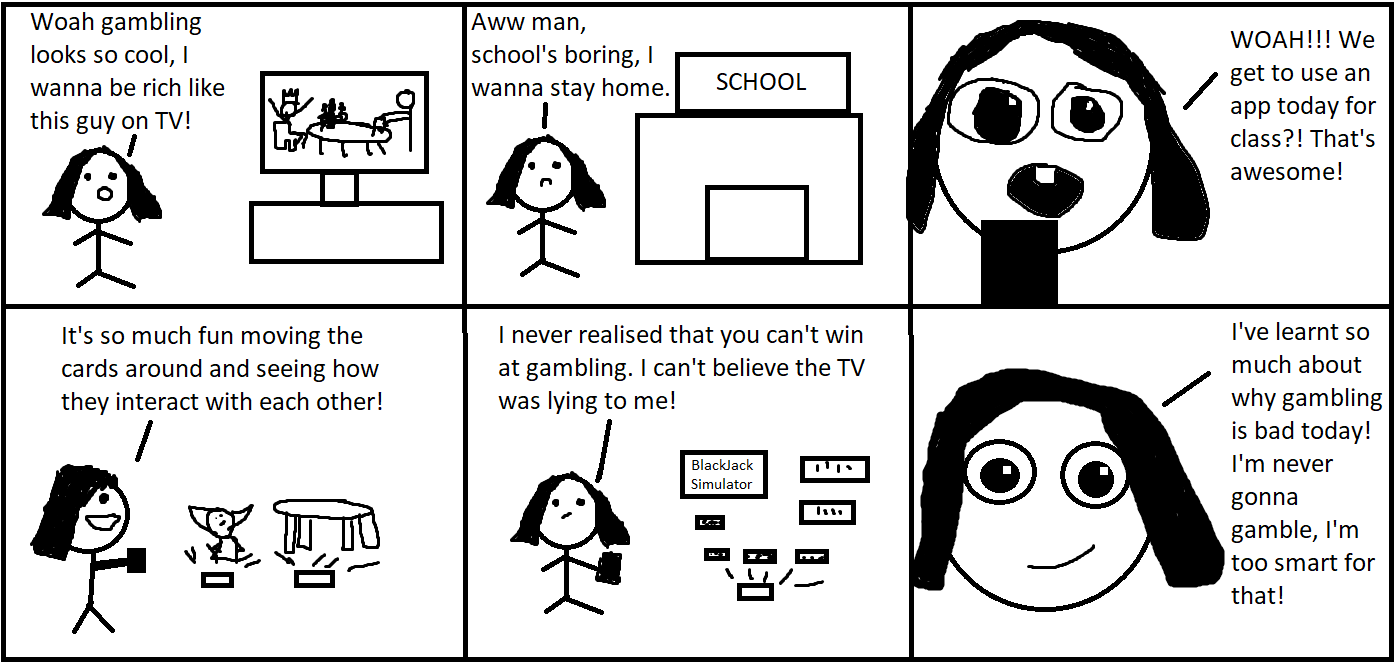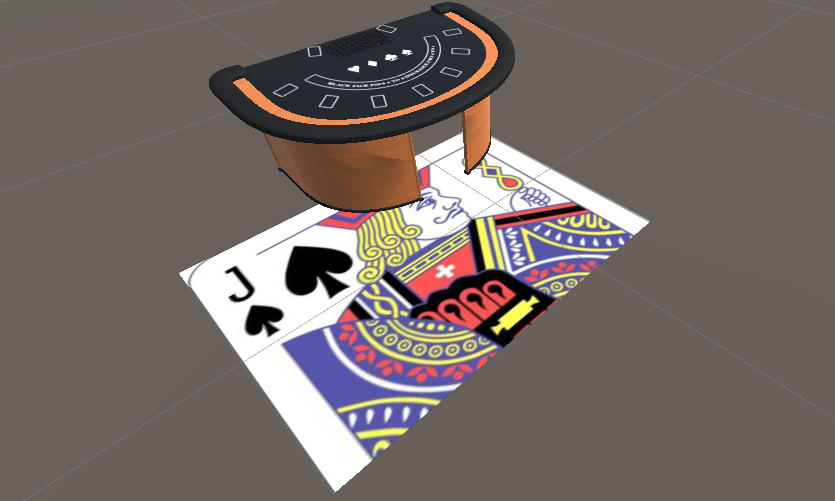KIT208 Assignment 3 Report
Introduction
Elevator Pitch
This application educates students on how casinos use probability to ensure that they always win. The final product would include many activities to reinforce the concepts of probability and common gambling fallacies, with the goal being to prevent users from becoming victims of problem gambling.
Full Prototype Playthrough
Application Description
This application educates users on how casinos use probability to make money. The prototype focusses on Blackjack, however the full application would also explore other gambling games. In addition, it would cover psychological aspects such as addiction and common gambling fallacies. By learning about probability users can develop a solid understanding of how gambling works and hopefully choose to not participate in it as a result. The current prototype includes a Blackjack simulator to show the effects of probability over time. The final app would aim to be included in primary / secondary school education.
The scenario interface problem is finding an engaging way to educate users on probability / gambling. Most school-based education is done verbally with visual slides, or online using a desktop interface. These methods can be very passive for students, which limits effective learning. This application is significant because it aims to further engage the bandwidth of the brain by including interesting interactions in 3D space that create a kinesthetic learning experience. A study of different learning styles among secondary students found that “there exists positive high correlation between Kinesthetic Learning Style and academic achievement of students” (Vaishnav 2013). This application would combine visual, auditory, and kinesthetic elements in order to effectively teach as many users as possible, and as such requires an interface that allows for this.
AR is a significant solution as it allows the user to freely operate in 3D space, which matches human characteristics. This interface provides intuitive human-computer interaction by manipulating real-world and digital objects in the same physical space. With this digital augmentation, users can be provided authentic experiences in areas where it would be unfeasible to try in the real world (Yen, Yaoyuneyong, & Johnson 2011). In the context of this application, users can be effectively educated on gambling and how casinos operate without needing to visit one. VR is an alternative interface solution, however AR was chosen due to its lower cost.
Interaction Design
The main interaction is physically moving the ‘guide’ card to different image targets to trigger explanation dialogue. This interaction has excellent affordance / mapping, as it makes intuitive sense that moving the guide to different objects would cause the guide to discuss them. This takes advantage of AR’s strength of operating in 3D space. The final application would have many unique cards for different activities. For example, an image target could present a model of a casino patron, where the guide explains physical signs of problem gambling and then asks the user to select which signs the casino patron model is showing.
In this prototype the ‘guide’ is the fictional character Yoda, however the final application would feature an original character. The guide aims to add levity to the serious nature of the application to help keep the user entertained and actively engaged. This is demonstrated by the interaction of pressing the pause button when Yoda speaks, where instead of pausing he berates the user and then permanently explodes the button. Including humorous, unexpected interactions would encourage users to fully explore the application and experiment, resulting in them being more engaged with the content and absorbing more information. Having the guide character operate in the same (augmented) physical space as the user helps to create a stronger attachment to them, which is a significant strength of AR.
Another interaction in this prototype is the Blackjack simulator, which allows users to witness probability in action. The UI is very straightforward, with buttons that clearly describe their function. Users can simulate one game at a time, where the odds of winning may not be immediately apparent. They could win their first five games and think that they’ve ‘beaten‘ gambling. However, if they start simulating 100 games at a time, they will quickly realise that losing is inevitable as the sample size increases. The world space UI includes a slider that represents the percentage of games won. By showing the slider in augmented physical space, the user can easily visualise probability in action, which takes advantage of AR’s strength of operating in the same space as the user. The final application would include many interactive experiences like this to help users visualise the effects of probability, specifically in the context of gambling.
Storyboard

Technical Development
Interface technology: AR (using Vuforia).
Development Software (Game Engine): Unity.
Interactions:
- Moving Yoda card near other cards to trigger dialogue.
- Pressing the pause button when Yoda speaks.
- Blackjack model increasing in size and rotating when Yoda card is near it, and shrinking / stop rotating when Yoda card is moved away.
- Pressing a button to show / hide the Blackjack basic strategy image.
- Pressing buttons on the Blackjack simulator to simulate 1, 10, or 100 games of Blackjack, with the results being dynamically printed, as well as a reset button to restart the simulator at 0 games played.
Description of 3D Models
Both 3D models in this application were sourced online.
- Lego Yoda: This model serves as guide for the user through the application. The model came with a front flip animation which is triggered when the card is first targeted.

- Blackjack Table: This model is used for learning about Blackjack probabilities and basic strategy.

References
Image Targets
- Jack of Spades: WikiMedia Commons 2017, 'File:English pattern jack of spades.svg', WikiMedia Commons, accessed 27/08/2022, available at: < https://commons.wikimedia.org/wiki/File:English_pattern_jack_of_spades.svg >
- Queen of Hearts: WikiMedia Commons 2012, 'File:English pattern jack of spades.svg', WikiMedia Commons, accessed 27/08/2022, available at: <https://commons.wikimedia.org/wiki/Main_Page >
- Yoda: 'Star Wars: The Empire Strikes Back (1980)', [Feature film], Directed by Irvin Kershner, Distributed by 20th Century Fox
Models
- Blackjack Table: AngryDruid 2012, 'Black jack table', TurboSquid, accessed 28/08/2022, available at: < https://www.turbosquid.com/3d-models/3d-black-jack-table-model/708000 >
- Blackjack Basic Strategy Image: BlackJack Apprenticeship 2022, 'Learn Blackjack Strategy', BlackJack Apprenticeship, accessed 27/08/2022, available at: < https://www.blackjackapprenticeship.com/blackjack-strategy-charts/ >
- Yoda Model: jannispfister 2022, 'Lego Star Wars Yoda Animated' Sketchfab, accessed 28/08/2022, available at: < https://sketchfab.com/3d-models/lego-star-wars-yoda-animated-d05c8e41b750457cbf5... >
Sounds / Effects
- Explosion Effect: Osama Deep 2016, '2d Flat Explosion', Unity Asset Store, accessed 28/08/2022, available at: < https://assetstore.unity.com/packages/2d/textures-materials/2d-flat-explosion-66... >
- Yoda Text-to-Speech: Vegito1089 2022, 'Yoda (by Vegito1089)', FakeYou, accessed 27/08/2022, available at: < https://fakeyou.com/ >
Information
- Blackjack Probabilities: Wizard of Odds 2016, 'Variance in Blackjack'., Wizard of Odds, accessed 27/08/2022, available at: < https://wizardofodds.com/games/blackjack/variance/ >
Software
- Unity Version 2022.1.7f1, Unity Technologies.
- Vuforia Augmented Reality SDK (2022), Vuforia Engine.
Academic References
- Vaishnav, R 2013, 'LEARNING STYLE AND ACADEMIC ACHIEVEMENT OF SECONDARY SCHOOL STUDENTS', Voice of Research, Vol. 1, Issue 4.
- Yen, S, Yaoyuneyong, G, & Johnson, E 2011, 'Augmented Reality: An Overview and Five Directions for AR in Education', Journal of Educational Technology Development and Exchange (JETDE), Vol. 4, Issue 1.
Files
Get Yoda's Gambling Awareness App [AR]
Yoda's Gambling Awareness App [AR]
| Status | Prototype |
| Author | corey_bigboi |
| Tags | Augmented Reality |